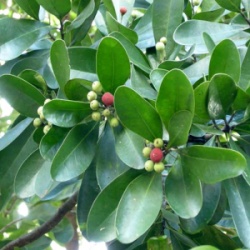Saro
From Wikiwel
Other Names : Cinnamosma fragrans, Mandravasarotra
Special Precautions and Side effects of Saro
Tisserand and Young indicate that due to its 1,8 cineole content, Saro Essential Oil may cause CNS and breathing problems in young children. They caution against using Saro Oil on or near the face of infants and children.
health Benefits and Uses of Saro
Uplifting, strong anti-viral, anti-bacterial, anti-fungal and anti-inflammatory properties.
- Saro is is an immunostimulant with superb anti-bacterial effects but without containing phenols.It aid the immune system due to its antiviral properties.
- Excellent for clearing nasal and sinus congestion and should be used in steam inhalations and chest rubs/liniments for colds and flus, bronchial conditions, etc. because of its excellent anti-infective and immunostimulant action, especially in viral conditions. Its camphorous/expectorant quality makes this an oil likely to be helpful with respiratory issues including easing coughs, asthma and bronchitis.
- as a support for all kinds of infections, including the skin, urinary tract, and digestion.
- This oil may also help balance oily, congested skin and scalp.
- The plant, which comes from Madagascar, is traditionally used against 'evil spirits' and may be used against the 'evil spirit' of today: burnout, fatigue and overwork.
- uplifting, vitalizing and energizing without causing olfactory fatigue, acting gently yet powerfully.
- acts deeply in helping with states of apathy, loss of motivation and the like.
- An amazing booster to self-confidence as well.
- Excellent for beating feelings of lethargy and drowsiness, as well as for mental fogginess and difficulty concentrating. Definitely a good ally to have on hand for studying or for situations where your mind needs to be sharp as a tack.
- Basic Chinese Medicine function: To tonify Qi and Yang, boost defensive Qi, raise Yang and strengthen the Mind.
References
Robert Tisserand and Rodney Young, Essential Oil Safety (Second Edition. United Kingdom: Churchill Livingstone Elsevier, 2014), 421.
